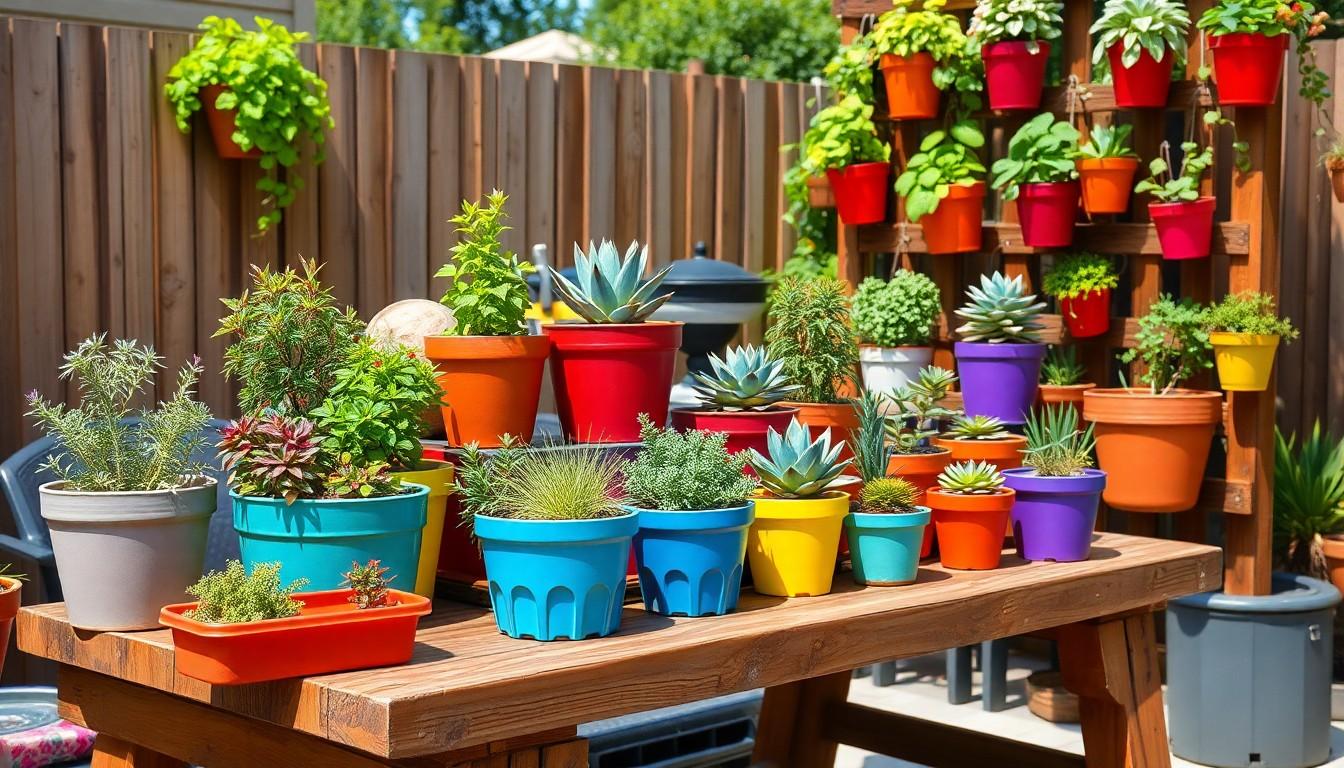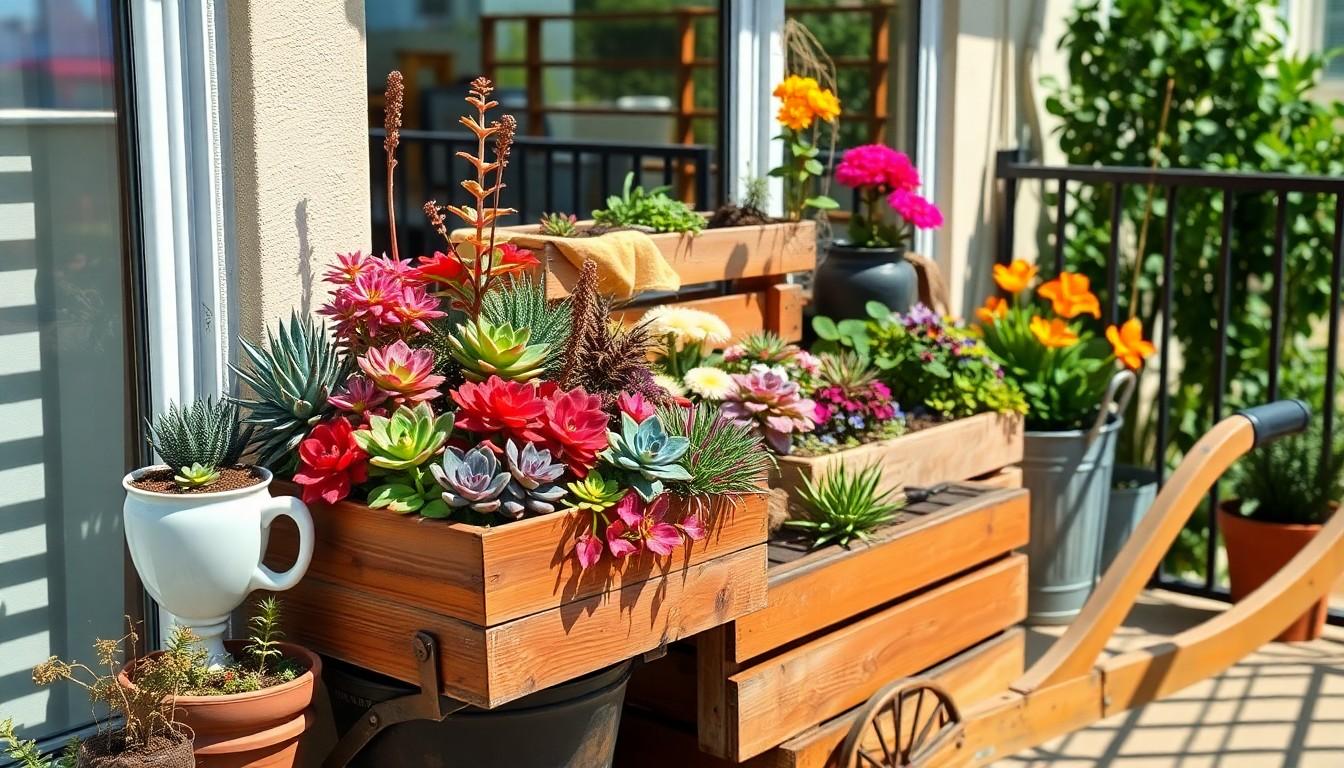Imagine transforming your tiny balcony or drab patio into a lush oasis without the need for a green thumb or a backyard the size of a football field. Creative container gardening is the answer to all your floral dreams, and it’s more fun than a cat in a sunbeam. With a little imagination and some unconventional containers, anyone can cultivate a vibrant garden that’ll make the neighbors green with envy.
From quirky teacups to repurposed wooden crates, the possibilities are endless. Not only does container gardening let you flex your creative muscles, but it also allows you to experiment with different plants and arrangements. So grab your favorite container and let’s dig into some delightful ideas that’ll turn your space into a botanical wonderland. Who knew gardening could be this stylish and entertaining?
Creative Container Gardening Ideas
Creative container gardening enables individuals to enhance small outdoor spaces with unique plants. Unconventional items like teacups, wooden crates, and old wheelbarrows serve as eye-catching containers. These alternatives bring personality to gardens, allowing for a diverse mix of plants. Various herbs and flowers thrive in smaller spaces, creating an inviting environment.
Combining colors and textures enriches the visual appeal. Succulents, for instance, complement vibrant annuals, while trailing plants add depth to arrangements. Grouping containers of different heights creates an engaging display. A flourishing herb garden in repurposed kitchenware captures attention while providing fresh ingredients for cooking.
The joy of container gardening lies in its flexibility. With careful planning, it’s possible to change arrangements seasonally. A winter display featuring evergreen plants contrasts beautifully with summer blooms. Selecting plants that suit specific conditions ensures growth success, regardless of a gardener’s experience level.
Experimentation retains a central role. Mixing in different materials like metal, ceramic, and fabric broadens design options. Vertically oriented containers maximize limited space, transforming walls into living art. Incorporating decorative elements such as stones or fairy lights elevates the ambiance.
Local nurseries and garden centers often stock plants suitable for container settings. Understanding which plants thrive in the target environment enhances overall success. Joining local gardening groups provides further inspiration and tips for planting and maintenance.
Ultimately, creative container gardening offers a fun, personalized approach to gardening. It invites exploration, encourages expression, and promotes community connection through shared ideas.
Popular Container Gardening Materials

Various materials play a crucial role in container gardening. These options cater to different styles, budgets, and gardening needs.
Wood
Wooden containers offer a classic, rustic charm. They are available in various shapes and sizes, providing ample room for plants to grow. Cedar and redwood resist rot, making them suitable for outdoor use. For added drainage, many wooden planters include slats at the bottom. Maintenance involves sealing or staining every few years to extend durability. These containers lend themselves well to vertical gardening, allowing for creative stacking configurations.
Plastic
Plastic containers provide lightweight, affordable solutions for gardeners. They come in an array of colors and designs, enabling personalization to match any aesthetic. Drainage holes often come pre-drilled, ensuring proper water management. UV-resistant plastic helps prevent fading, allowing these containers to withstand outdoor elements. Easy handling makes them ideal for rearranging as seasons change. Additionally, many plastic pots can accommodate a wide range of plants, from succulents to herbs.
Metal
Metal containers present a modern, industrial look that complements contemporary spaces. Galvanized steel or aluminum provides durability while adding a sleek appearance to the garden. These materials heat up quickly, promoting warm soil for fast-growing plants. It’s important to include drainage holes to avoid waterlogging. Metal planters can easily be incorporated into vertical gardens or hung on walls, creating striking visual displays. Additionally, rust-resistant coatings help maintain their aesthetic appeal over time.
Innovative Container Gardening Techniques
Innovative container gardening techniques expand possibilities for vibrant outdoor spaces. Unique methods help create eye-catching displays and maximize plant growth.
Vertical Gardening
Vertical gardening utilizes walls and trellises to cultivate plants in limited spaces. This technique allows for the growth of climbing plants like peas and beans, which can be trained upwards. Using vertical planters or wall-mounted pockets maximizes sunlight exposure and enhances air circulation. Combining it with trailing plants, such as ivy or string beans, adds depth to the display. Such arrangements can transform fences or small balconies into lush gardens while conserving floor space effectively.
Hanging Gardens
Hanging gardens offer an exciting way to incorporate greenery at different heights. Suspend containers from hooks or brackets to create dynamic layers in the garden. Select plants with varying growth habits, such as cascading petunias or hardy ferns, to provide visual interest. Utilizing recycled materials, like old colanders or baskets, adds a creative touch and promotes sustainability. These gardens beautify porches and patios while attracting pollinators and providing fresh herbs for culinary use.
Combined Planters
Combined planters blend various plants and container types for unique arrangements. Using large containers for tall plants, like sunflowers or ornamental grasses, establishes a focal point. Surrounding these with low-growing flowers or herbs emphasizes colors and textures. Mixing materials, including ceramics and plastics, can evoke contrast and interest. Layering plants with differing bloom times ensures continuous beauty throughout the growing season. This method cultivates biodiversity and helps optimize limited gardening environments.
Choosing The Right Plants
Selecting the perfect plants is essential in creative container gardening. Various factors influence this choice, including seasonal changes and plant compatibility.
Seasonal Considerations
Understanding seasonal variations significantly impacts plant selection. Choose plants that thrive in the specific climate like vibrant flowering annuals for summer. Cool-weather veggies such as kale and pansies work well in fall or spring containers. Some plants may prefer full sunlight while others thrive in shade; consider these conditions when selecting a site. Planting perennials in containers also provides a delightful rotation, allowing new blooms each year. These seasonal dynamics encourage creativity, which leads to engaging and diverse displays.
Companion Planting
Grouping compatible plants fosters healthy growth and enhances beauty. Combine herbs like basil with tomatoes to improve flavors and repel pests. Grouping marigolds with vegetables may deter harmful insects, creating a healthier garden environment. Invest in knowledge by researching which plants coexist harmoniously. Their compatibility supports overall garden health and provides visual interest when arranged thoughtfully. Diverse containers featuring complementary plants create stunning displays while maximizing the gardening experience.
Tips For Successful Container Gardening
Successful container gardening relies on a few key principles. Understanding these principles can enhance the gardening experience and yield vibrant results.
Soil and Drainage
Choosing the right soil ensures healthy plants. Use a high-quality potting mix that provides adequate nutrients and drainage. Incorporating organic matter enhances soil fertility while improving structure. Opt for containers with drainage holes to prevent water accumulation. Adequate drainage promotes healthier root systems. Adding a layer of small stones or gravel at the bottom of containers helps with further drainage. This simple practice prevents overwatering and soil saturation.
Watering and Maintenance
Establishing a consistent watering routine is essential for container gardens. Containers dry out faster than in-ground gardens, so frequent checks for moisture levels are important. Water thoroughly until it drains from the bottom, ensuring roots absorb the moisture. Mulching can help retain water and reduce evaporation. Regular maintenance includes removing dead leaves and spent flowers. Fertilizing every few weeks supports continuous growth and blooming. Additionally, observing plants for pests or diseases ensures prompt action, maintaining a healthy garden environment.
The Art of Creative Gardening
Creative container gardening opens up endless possibilities for transforming small spaces into lush retreats. By embracing unconventional containers and experimenting with plant combinations, anyone can cultivate a personalized garden that reflects their style.
The flexibility of container gardening allows for seasonal updates and the chance to try new techniques, ensuring fresh inspiration year-round. With the right materials and plants, even the tiniest balconies or patios can burst with life and color.
Encouraging community connections through shared gardening experiences further enriches this enjoyable hobby. Whether a novice or an experienced gardener, the world of container gardening invites everyone to explore their creativity and enjoy the beauty of nature right at home.

